Nearly every trade and home has a use for a utility knife. While basic in concept, the best utility knives are super-handy and really can make your job easier. So, whether you’re cutting up boxes on recycling day, removing sealant, or any of dozens of other jobs, take a look at these top candidates and see if there’s something on the list that suits your needs.
Here’s the deal—you can pick up a cheap utility knife and it will work just fine in most cases. What I’m focusing on are the ones that set themselves apart from the norm. Each of these models has that special something that makes them worth spending a few more dollars on to gain function or ease of use that you won’t find on entry-level options.
Our Top Picks
- Best Folding: Milwaukee Fastback 48-22-1502 – Buy at Acme Tools
Jump to this Utility Knife ↓ - Best Snap-Off: OLFA 18mm Auto Locking MXP-AL – Buy on Amazon
Jump to this Utility Knife ↓ - Most for Drywall: Milwaukee Fixed Blade 48-22-1513 – Buy at Acme Tools
Jump to this Utility Knife ↓ - Best for Construction: Gerber Prybrid 31-003745 – Buy on Amazon
Jump to this Utility Knife ↓ - Best w/ Unexpected Features 1: ToughBuilt Utility Knife/Scraper TB-H4S5-01 – Buy on Amazon
Jump to this Utility Knife ↓ - Best w/ Unexpected Features 2: ToughBuilt Reload TB-H4S2-03 – Buy at Lowe’s
Jump to this Utility Knife ↓
Also In This Article
- Best-Selling Utility Knives
- Best Utility Knife Models – More Recommendations
- Best Utility Knife Buying Guide
- Why You Can Trust Pro Tool Reviews
Related Content
Best Folding Utility Knife
Milwaukee Fastback 48-22-1502
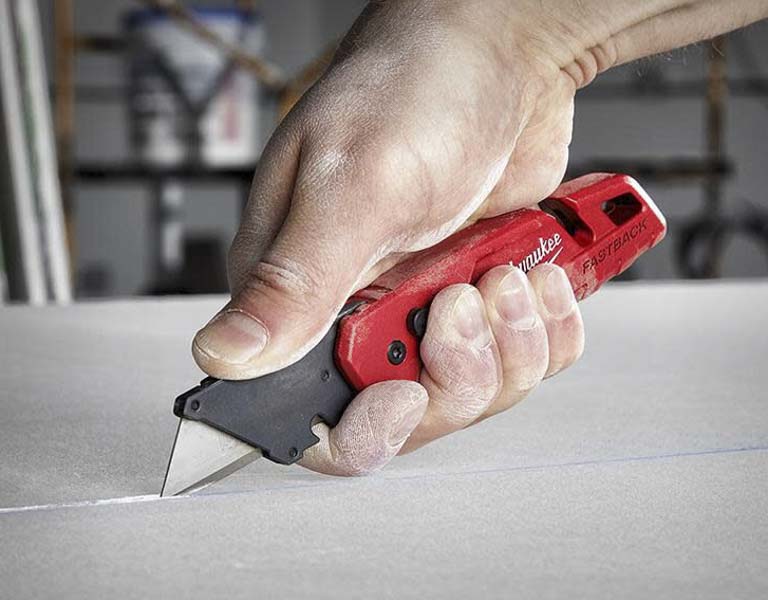
Milwaukee’s product team has spent a lot of time developing trade-focused solutions for the trades, including the Fastback line of utility knives. What I love about the 48-02-1502 is its folding and locking function. I prefer its flip-out action over traditional push-out blades because I’m able to use it more like my EDC pocket knife. This isn’t the only model that flips out in Milwaukee’s line, though. I like this one the best because of its metal construction, integrated wire stripper, and 5-blade onboard storage.
Key Features
- Uses standard trapezoidal blades
- Durable metal construction
- Press and flip the opening
- Quick blade changes
- Metal support extension prevents accidental blade release
- Durable wire belt clip
- Integrated wire stripper and gut hook
- Blade holder doubles as a scoring tool
- Stores 5 additional blades onboard
- Tether-ready frame
Price: $14.97 (single tool) or $56.99 (4-pack w/ blade storage)
Best Snap-Off Utility Knife
OLFA 18mm Auto Locking MXP-AL
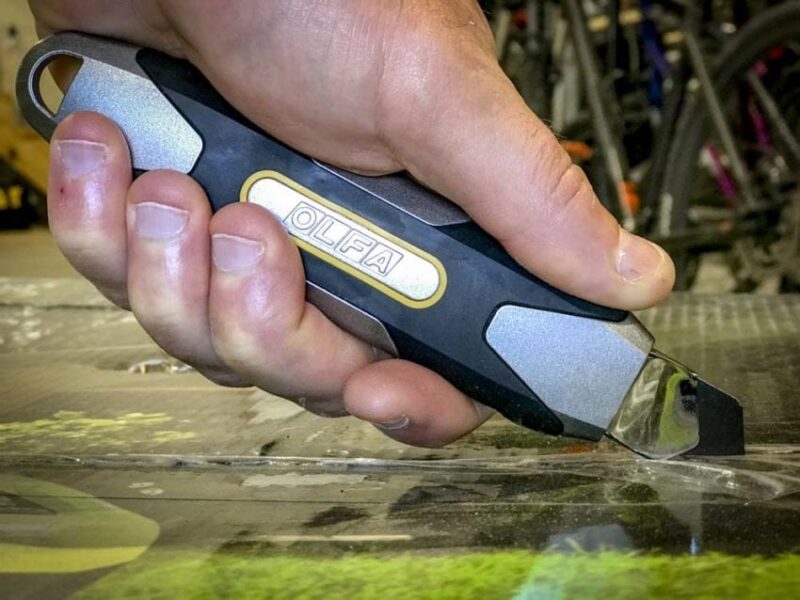
If you want to talk to someone who’s obsessed with every aspect of utility knife development, talk to the folks at OLFA. From the top of their lineup to the bottom every single element of the design is intentional. In their extensive line, my favorite is the 18mm MXP-AL.
I like the aluminum body construction over plastic, and the 18mm size fits comfortably in my hand. Plus, the extendable blade can make cuts several inches deep—something you can’t do with a trapezoidal blade.
While the knife’s overall design is outstanding, the entire system sets this one even further apart. OLFA’s blade design is second to none, with multiple options depending on how you want to balance cutting performance and price. Then there are the blade disposal cans that let you easily snap off a used section of blade directly into a container where you don’t have to hunt it down or risk getting cut if you or someone else picks it up.
As a side note, I also really liked the Lenox Fast Snap, but that one is no longer available.
Key Features
- Usus 18mm blades
- Auto-locking extendable blade (also available with a ratcheting wheel lock)
- Die-cast aluminum body
- Stainless steel blade housing
- Wrap-around rubber overmold grip
- Quick, tool-free blade changes
- Includes a Black-series blade
Price: $17.49
Best Utility Knife for Drywall
Milwaukee Fixed Blade 48-22-1513
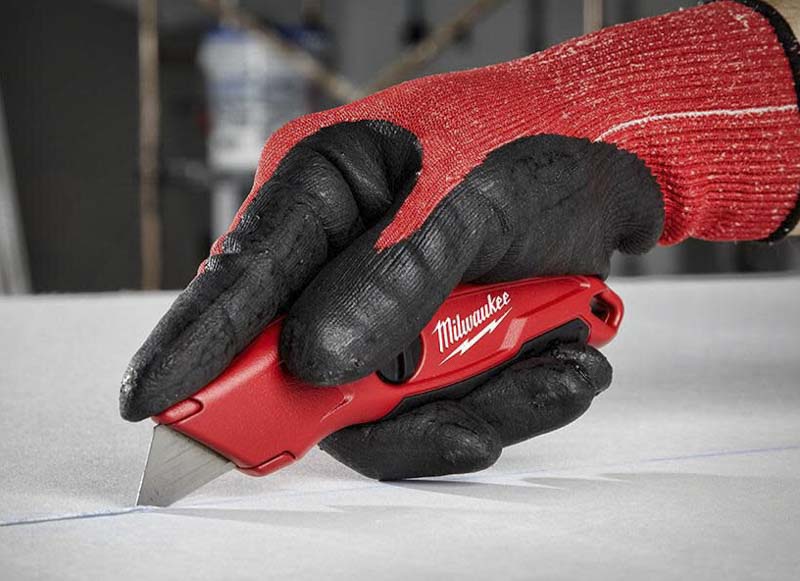
For scoring drywall, I like an angled utility knife for its better control and visibility. I also like a fixed blade or a flip-out model so there’s less chance of wobble at the blade. While there are plenty of great options available with this design, I like the simplicity and ergonomics of Milwaukee’s 48-22-1513.
It has the fixed blade I’m looking for and enough angle to relieve strain on my wrist and provide that additional control and visibility, yet it’s still useful for standard cutting tasks since the angle isn’t too hard. The metal body does great on the jobsite, it stores up to five additional blades inside, its shape has a nice feel in hand, and it’s less than $10.
Want to learn more about the cost of drywall installation? We can help!
Key Features
- Uses standard trapezoidal blades
- Fixed blade design
- Stores five additional blades on board
- Overmolded grip
- Tool-free blade changes
Price: $8.99
Best Utility Knife for Construction
Gerber Prybrid 31-003745
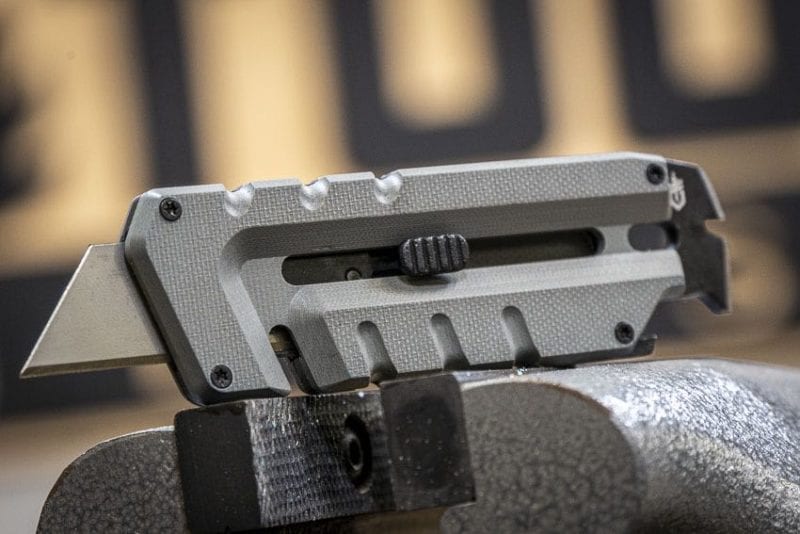
I wouldn’t have thought a utility knife on a multitool would impress me, but the Gerber Prybrid was a nice surprise with a variety of features that are a good fit for construction workers. With its metal construction, the Prybrid combines a slide-out utility knife with a pry bar, nail puller, wire stripper, two flathead screwdriver sizes, a bottle opener, and a cord cutter. Putting eight tools together isn’t in itself a big deal. But doing it in a way that keeps the physical form legitimately useful as a go-to utility knife. The only thing I’d like to see the design add is a pocket clip.
Our team was so impressed that it made our list of the best multi-tools.
Key Features
- Uses standard trapezoidal blades
- Auto-locking push-out blade design
- Includes eight tools
- Durable metal construction
- Textured surface improves grip
- Includes a lifetime warranty
Price: $30
Best Utility Knives with Unexpected Features
ToughBuilt Utility Knife/Scraper TB-H4S5-01
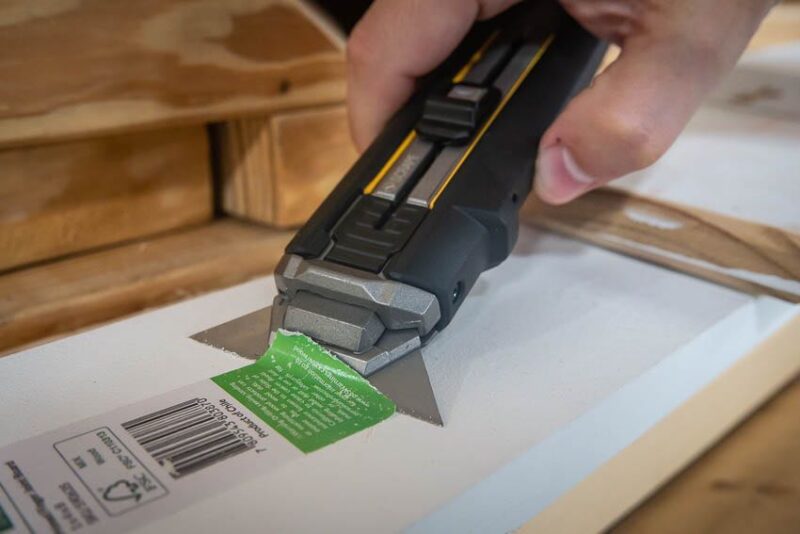
Of the two ToughBuilt utility knives I’m going to highlight, the most useful is the Scraper Utility Knife. At first glance, it seems like a relatively standard design, though its spring-loaded lock and release are different from most models. However, when you push the blade forward all the way, it rotates 90° to a scraper orientation. Push it forward again, and it returns to a utility knife orientation.
My only minor complaint is that the design is larger than I prefer. However, if you use both functions often, it’s easy to get used to.
Key Features
- Uses standard trapezoidal blades (5 included)
- Simple, tool-free scraper and utility knife conversion
- Spring-loaded blade lock and release
- Easy, quick blade replacement
- Rubber overmold grip
- Integrated paint can opener and lanyard hole
Price: $19.98
ToughBuilt Reload TB-H4S2-03
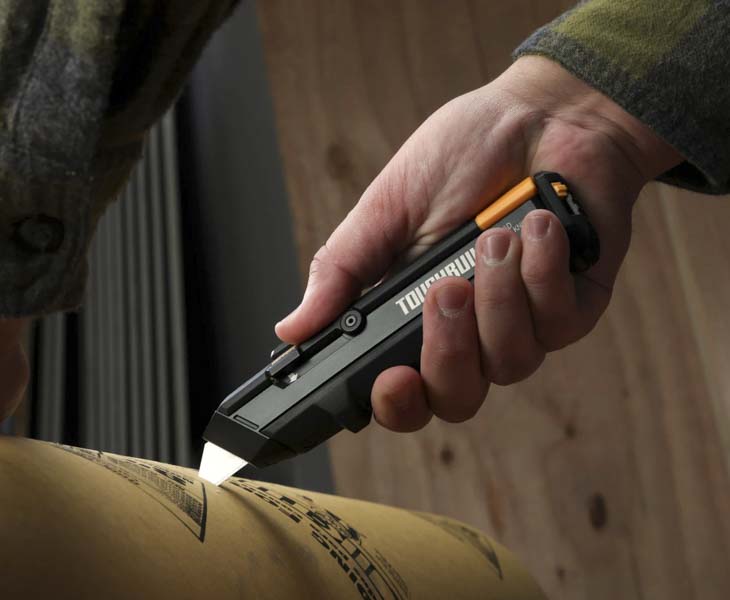
The other ToughBuilt Utility Knife I’m highlighting makes lightning-fast blade changes in the coolest way possible. It’s a magazine-fed system like nothing we’ve seen before. The magazine holds 15 blades—5 in the auto-load section and 10 spares. Yes, we said auto-load. When your blade is at the end of its life, you remove it through the top. When you cycle the pusher back, it automatically loads the next blade and exposes it when you push forward again.
The magazine itself has a drop-out release, and yes, you can go full Keano Reeves with magazine changes and bring your own John Wick vibe to the jobsite.
Key Features
- Uses standard trapezoidal blades
- Automatic blade loading
- Stores up to 15 blades in the magazine (5 in the auto-load position)
- Magazine drop-out quick-release
- Includes straight and hooked blades
- Includes two magazines
- Rubber overmolded grip
- Indicator switch identifies which blade type is installed
- Lifetime warranty
Price: $19.98
Best Utility Knife Brands
If you forced me to narrow down my choices to the number one best utility knife brand, I’d be torn between Milwaukee and OLFA. Milwaukee’s Fastback models are my go-to for a flip-out design on days when I need something that wears more like a pocket knife. The build is solid, the features are meaningful, and there’s a wide range of models to suit your needs.
When I want the length or convenience of an extendable break-off blade, OLFA is where I turn. I prefer their all-metal design, but even the ones with plastic housings are still built to thrive in tough jobsite environments. Combined with OLFA’s blades—which are the best in the business in my opinion—it’s an unbeatable combination for standard cutting tasks.
Best-Selling Utility Knives
In addition to exploring our top picks, you may find it helpful to see what others are buying. Here are some of the best-selling utility knives at leading retailers.
Acme Tools
- Milwaukee Fastback Flip-Blade Utility Knife 48-22-1901X4 – $36.99
- Tajima Blue Retractable Blade One-Piece Utility Knife VR-102B – $26.50
- Bessey Utility Knife Set with Zippered Nylon Case DBKPHSET – $38.99
Amazon
- REXBETI Utility Knife 2-Pack REX056 – $9.99
- Gerber Gear EAB Lite Pocket Knife with Money Clip 31-000345 – $13.70
- WORKPRO Folding Utility Knife with Blade Storage Handle W011009A – $14.99
Lowe’s
- Kobalt 3/4-in 3-Blade Retractable Utility Knife 55908 – $5.98
- Lenox 3/4-in 1-Blade Folding Utility Knife 10771FLK1 – $10.98
- Craftsman 3-Blade Retractable Utility Knife CMHT10585 – $5.98
Home Depot
- Husky Folding Lock-Back Utility Knife (3-Pack) 99732 – $21.97
- Milwaukee Fastback Compact Folding Utility Knife 48-22-1500 – $9.97
- Stanley Quick-Change Retractable Utility Knife (2-pack) STHT10274 – $12.97
Best Utility Knife Models – More Recommendations
The picks above aren’t the only utility knives worth owning, but they’re certainly my favorites. If you’re looking for something else, the following tried-and-true options may be a better fit.
DeWalt Retractable DWHT10295
This angled retractable model features a comfortable overmolded grip, blade storage, and a spring-load carabiner clip. Plus, it’s made in the USA using global materials.
Price: $12.99
Klein Cable Skinning Utility Knife 44218
Paired with a replaceable hawkbill blade, this specialty folding model is specifically designed to help electricians skin cable and quickly swap blades once they get dull.
Price: $21.97
Knipex CutiX 90 10 165 BKA
Separate locks for the 18mm snap-off blade and stabilization bar pair with a lightweight magnesium housing in this premium utility knife.
Price: $32.98
Roberts Cut and Jam Carpet Knife 10-220
This dual-purpose model is specially designed to help carpet installers with both cutting a tucking tasks. It features rugged all-metal construction and can hold ten spare blades in the handle.
Price: $11.78
Stanley Retractable STHT10479
This is another angle retractable utility knife with a comfortable overmold grip and storage space for ten blades. It comes with a limited lifetime warranty.
Price: $11.99
Best Utility Knife Buying Guide
The following sections were written by Clint Deboer
Which Utility Knife Do I Need?
Ask yourself some of the following questions when searching for the perfect utility or razor knife:
- How do I intend to use it?
- What are the basic kinds of utility knives?
- What’s the best blade type for me?
- Do I need to use a safety mechanism?
- What type of blade-changing mechanism do I want?
How Do I Intend to Use the Knife?
Depending on your application, you may prefer a folding utility knife. If you go through blades like there’s no tomorrow, you’ll want something with ample blade storage. This sounds like an easy question, but realize that utility knives are made in specific ways for specific tasks.
For those laying carpet, you’ll want a knife that is always ready and can handle quick, painless blade changes (which you’ll be doing at a rate of about—oh, I don’t know—once per minute, lol.) If you just want something for general use (opening packages, sharpening pencils, etc) then consider going with a standard knife. Models with a retractable blade can easily take a new blade when needed.
Alternatively, a folding razor knife might be the ticket for those wanting something different. Or, consider a smaller-profile knife with segmented, breakaway blades. Those qualify in this category as well. In either case, it’s important to match the knife to your intended use—or plan on picking up a couple of different tools.
Basic Types of Utility Knives
There are three essential types of utility knives. If you want the best utility knife for your application, understand each one. I’m sure you can come up with a few more that might deserve their own category, but for the sake of simplicity, we’ll stick to the following:
Retractable Knives
These knives are the most common utility variety and feature a sliding blade mechanism with variable depth. Actuation is typically through a button that is depressed with the thumb to expose the knife and control the depth of the blade (some knives are all or nothing).
Most retractable knives can accept multiple blade types, but this varies from manufacturer to manufacturer. Simple versions feature a straight handle and some kind of screw to separate the device and load spare blades, while advanced models may be more ergonomic in shape and offer quick-release blade changes.
Safety Knives
Some safety knives auto-retract or force you to squeeze a trigger to extend the blade. OSHA requires these tools on certain jobsites to meet various safety standards. Most users dislike using them as they violate every rule of ergonomics. However, when you have to use them, make sure you grab one that helps you work as efficiently as possible.
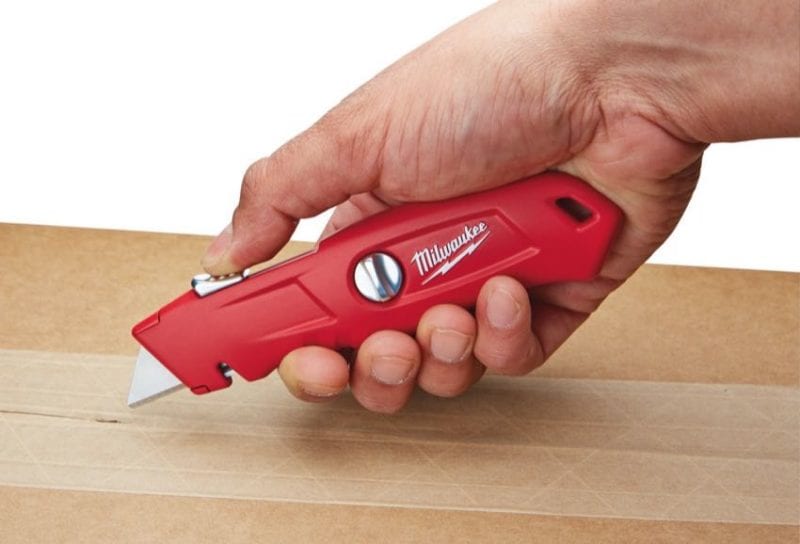
Fixed-Blade Knives
These knives are perfect for heavy-duty use and precision cuts. Since the blade gets locked into a single position, the knife experiences no “blade slop” or side-to-side wiggle which is common in standard retractable knives. Since the blade doesn’t retract, it’s important to carefully store these knives or even remove the blades when not in use.
These knives are most commonly found in the carpeting industry and they can typically accept many different types of blades. Apart from the common full-sized knife, certain hobby knives are also fixed-blade in design and can support ultra-sharp blades of various sizes and shapes that are used for precision cuts.
Folding Utility Knives
A variation of the fixed-blade knife includes folding knives. These feature the stability of a fixed blade with the fold-away protection of a retractable blade. They also give you a much more compact footprint.
Snap-Off Blade Knives
Snap-off blade knives feature segmented blades that are broken off in sections to deliver a brand-new edge once the old one is too dull to be useful. They let you continue cutting without the need for a blade change. These knives started out catering to hobbyists where heavy-duty use wasn’t required. Now, OLFA makes segmented utility knives with heavy-duty snap-off blades that can hold up to jobsite use. Most blades come with anywhere from 8 to 13 segments.
Types of Utility Knife Blades
Several blade types will make each type of job much easier. Here are some of the more common styles you can buy:
Standard Utility Blades
These are the typical trapezoidal razor blades you see on full-size utility knives. Their trapezoidal shape gives you pointed edges for cutting materials of varying degrees of thickness and composition.
Round-point Utility Blades
These are identical to standard utility blades except for blunted points. This avoids accidental stabbing while still allowing for maximum cutting ability on a variety of materials. Some jobsites might require these for safety reasons.
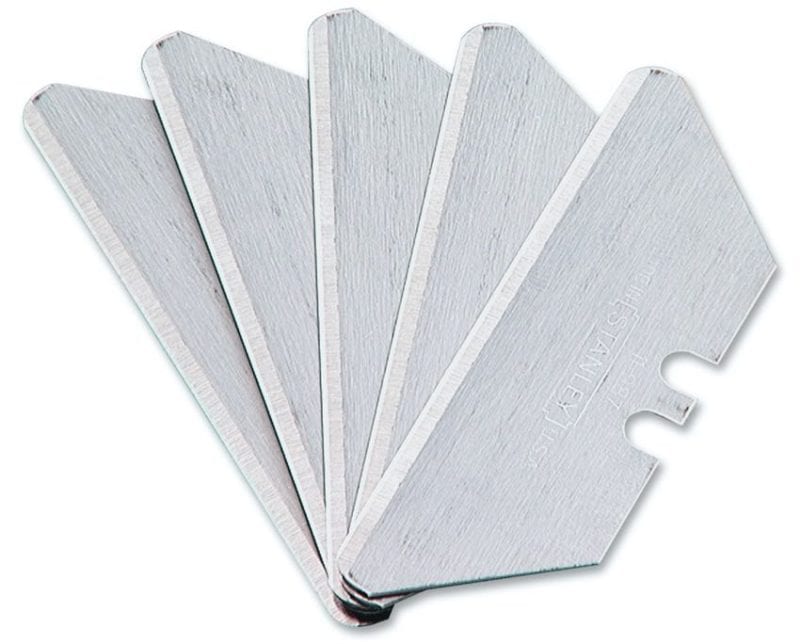
Hook Blades
These blades are excellent on linoleum or carpet and allow for rapid cutting of those and similar materials. These blades come in a variety of sizes, and can also include blunt ends or single/dual-sided forms. A variant on this blade is the Linoleum blade which is typically single-sided and features a single arched blade hook.
Carpet Blades
These blades are typically rectangular and double-sided. Pros use them with specialty fixed utility knives that can accept them.
Snap-off Blades
Snap-off blades include standard wedge-type blades for smaller hobby knives and heavier-duty segmented blades. Some manufacturers offer these in varying thicknesses and materials, so pay attention to the application and materials you need to cut.
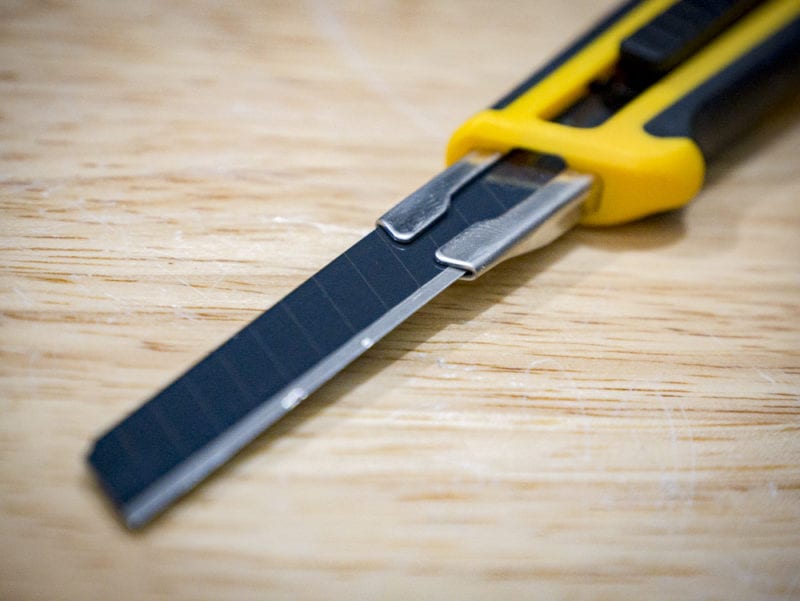
Scoring
These are almost always sold as a separate system but they are worth mentioning since they are used extensively in construction to cut various materials like cement board. These blades come in a variety of shapes and sizes. They let you score material designed to be snapped rather than cut through with a blade.
Best Utility Knife Features
Look for the following features in a utility or razor knife to enhance and expand upon the standard features you’d expect to find in a knife. Sure, you can get a straight-up blade with no frills, but some of these nifty features make using a utility knife something much more useful.
Folding Blade
A new trend is to treat the standard utility knife like a Kershaw folding pocket knife. As far as we can tell, this was pioneered by a company called Superknife and then quickly knocked off by many other manufacturers. Instead of the sharpened steel blade, you have a removable razor blade that is locked into a folding arm.
‘It typically locks away when not in use and makes for a great addition to throw into a tool bag—or your pocket for that matter. There are also utility knives with handles that bend but do not completely fold. This is mainly an issue of ergonomics, and these knives otherwise resemble standard, non-folding knives.
Quick Blade-Change Mechanisms
While some people prefer “old school” utility knives that require a flat-head screwdriver to separate the body into halves to change the blade, our personal favorite are the models that use a simple button to swap blades.
With the simple push of a button, you can flip the razor blade around to the fresh side and continue use. Other knives feature a spring-loaded mechanism that can pivot or split the knife open and allow fast blade changes.
Onboard Blade Storage
Most utility knives offer internal blade storage, but increasingly, knives are coming up with more convenient ways to access those blades. While older knives had to be disassembled, new knives feature quick-release compartments and deliver much easier access to five or more spare blades.
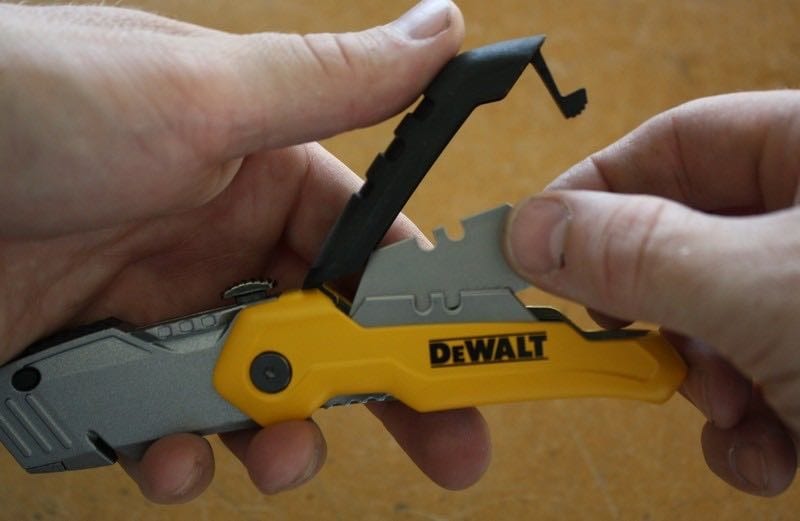
String-Cutter
Some knives include a small slit in the body that accesses a small area of the blade just behind the head of the knife. This is perfect for slicing strings and twine without having to adjust the knife. It’s safe and easy to use.
Why You Can Trust Pro Tool Reviews
Ever check out a “review” site and you can’t tell if they actually tested the tools or if they’re just “recommending” the Amazon top sellers?
That’s not us. We only recommend what we’d use, even if we don’t earn a commission from it. It’s all about giving you a legitimate recommendation and our honest opinion of each product.
We’ve been in business since 2008 covering tools, writing reviews, and reporting on industry news in the construction, automotive, and lawn care industries. Our Pro reviewers work in the trades and have the skills and experience to know whether tools can perform well in the field.
Each year, we bring in and review hundreds of individual products. Our team will put our hands on hundreds more at media events and trade shows throughout the year.
We consult with innovators in the technology and design of tools to gain a broader grasp of where these products fit and how they work.
We work with more than two dozen professional contractors around the United States who review products for us on real job sites and consult with us on testing methods, categories, and weighting.
We’ll provide more hundreds of pieces of new content this year absolutely free for our readers—including objective evaluations of individual tools and products.
The result is information you can trust because of the editorial, scientific, and real-world professional experience we collectively utilize each and every time we pick up and test a tool.



